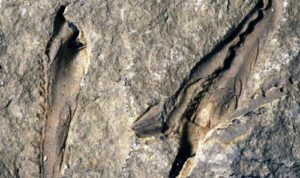
An international team of scientists, including researchers from the University of Bristol, Lund University in Sweden and the Royal Ontario Museum, has discovered a new species of extinct, marine worms—called Websteroprion armstrongi—that lived about 400 million years ago and had snapping jaws.
According to scientists, this species grew to an estimated 3 feet in length, and is probably Earth’s oldest “Bobbit worm.”
The modern Bobbit worms live on ocean floors and can grow about 10 feet in length. They hide themselves beneath the sand and then attack fish and octopi by shooting out a fraction of their body. Their jaws “resemble scissors, or because the exposed portion [of the body] resembles an erect penis.” These creatures get their name from Lorena Bobbitt, an American woman who cut off her husband’s penis with a knife in 1993.
W. armstrongi was identified from several ancient jaw fossils stored at the Royal Ontario Museum in Toronto. These fossils were found by Ontario Geological Survey researcher Derek Armstrong in 1994 near Moosonee town in Canada. Reaching 0.4 inches in length, the fossilized jaws were considered to be the largest jaws recorded in ancient marine worms. Researchers also estimated (seeing the jaw size) that W. armstrongi was over 3 feet in length.
“Gigantism in animals is an alluring and ecologically important trait, usually associated with advantages and competitive dominance,” lead author Mats Eriksson from Lund University said in a statement.
“It is, however, a poorly understood phenomenon among marine worms and has never before been demonstrated in a fossil species.”
“The new species demonstrates a unique case of polychaete gigantism in the Palaeozoic, some 400 million years ago.”
Co-author Luke Parry from the University of Bristol’s School of Earth Sciences, said: “It also shows that gigantism in jaw-bearing polychaetes was restricted to one particular evolutionary clade within the Eunicida and has evolved many times in different species.”
“This is fitting also since, beside our appetite for evolution and paleontology, all three authors have a profound interest in music and are keen hobby musicians.”
David Rudkin from the museum said: “This is an excellent example of the importance of looking in remote and unexplored areas for finding new exciting things, but also the importance of scrutinizing museum collections for overlooked gems.”
The detailed information about this species has been published in the journal Scientific Reports.